Phosphorus Cycle and Removal from Wastewater
村上定瞭(水浄化フォーラム), Sadaaki Murakami (Water & Solutions Forum)
1.リンの循環
2.リンの用途
3.生物学的リン除去
(1) リン除去の基本原理
(2) リン除去プロセス
(3) 窒素・リンの同時除去プロセス
4.不溶性塩によるリン除去
(1) 凝集沈殿法
(2) 晶析法
(3) 鉄電解法
参考文献
関連ページ:窒素除去
1. Circulation of phosphorus
2. Uses of phosphorus
3. Biological phosphorus removal
(1) Basic principle of phosphorus removal
(2) Phosphorus removal process
(3) Simultaneous removal process of nitrogen and phosphorus
4. Phosphorus removal with insoluble salts
(1) Coagulation sedimentation method
(2) Crystallization method
(3) Iron electrolysis method
References
Related page: Nitrogen removal
1.リンの循環
リンは、遺伝子DNA・RNAのポリリン酸エステル鎖として存在するほか、生体エネルギー代謝に欠かせないATPや細胞膜を構成するリン脂質など、生命の維持に重要な役割を担っている。脊椎動物ではリン酸カルシウムが骨格の主要な構成要素となっている。リンは生物の必須元素であり、地球上におけるリンの存在量が、地球生態系のバイオマスの限界量を決定すると言われている。
生物の体を構成する炭素や窒素は、空気を通して物質循環が成り立っている。しかし、自然界ではリンは水に溶解した状態か難溶性塩として固体で存在する。海水中のりん含有量は0.07mg/kgであるのに対し、人体では6,300mg/kgで濃縮係数は90,000である。この濃縮係数はナトリウム 0.22、カリウム 5.8、カルシウム 34.5、鉄 5,000などと比べて、極めて高い値となっている。
主なリンの循環経路は、植物が枯死するか、その植物を食べた動物が死ぬと、微生物に分解されて土壌に戻り、再び植物の根から吸収される。また、地表水に運ばれて海域に流出してしまうリンも少なくなく、そうしたリンが海底で堆積してできるのがリン灰石である。地殻変動によってリン灰石が地表に現れるには100万年以上の時間がかかると言われる。
海洋においては浅い地域に多く、元素の中では偏在性が強い。メキシコ、コンゴ、南米付近の海底には大規模なリンの鉱床がある。
以上述べたように、リンは生物にとって極めて貴重な元素である。しかし、もともと自然界におけるリンの存在量が少ない状況の中で、リン鉱石を利用する現在の人間の生活・産業活動によって、リンが湖沼や海域へ流入すると、植物プランクトンや藻類(アオコや赤潮など)が異常に繁殖し、これらが沈降して、底質で分解し、リンが再溶出して植物がさらに繁殖して水質悪化が進行することとなる(富栄養化)。
1. Phosphorus circulation
Phosphorus exists as a polyphosphate ester chain of gene DNA/RNA, and also plays an important role in sustaining life, such as ATP and phospholipids that compose cell membranes, which are essential for bioenergy metabolism. In vertebrates, calcium phosphate is the major constituent of the skeleton. Phosphorus is an essential element of living organisms, and it is said that the amount of phosphorus present on the earth determines the limit amount of biomass in the global ecosystem.
Carbon and nitrogen, which make up the body of living things, have a material cycle through air. However, in the natural world, phosphorus exists in a state of being dissolved in water or a solid as a sparingly soluble salt. The phosphorus content in seawater is 0.07 mg/kg, while the concentration in human body is 6,300 mg/kg and the concentration factor is 90,000. This concentration factor is extremely high compared to sodium 0.22, potassium 5.8, calcium 34.5, iron 5,000, etc.
The main circulation route of phosphorus is that when a plant dies or an animal that eats the plant dies, it is decomposed by microorganisms and returned to the soil, and is absorbed from the roots of the plant again. In addition, there are not a few phosphorus that are carried to the surface water and flow out to the sea area, and it is apatite that accumulates on the seabed. It is said that it takes more than one million years for apatite to appear on the surface due to crustal deformation.
In the ocean, it is often found in shallow areas and is highly unevenly distributed among elements. There are large-scale phosphorus deposits on the seabed near Mexico, Congo, and South America.
As mentioned above, phosphorus is an extremely valuable element for living things. In the situation where the amount of phosphorus in the natural world is small originally, however, when phosphorus flows into lakes and marine areas due to the current human life and industrial activities that use phosphorus ore, phytoplankton and algae are abnormally propagated (such as blue water and red tide), these will settle down and decompose in the bottom sediment, phosphorus will be re-eluted, the plant will further propagate, and the water quality will deteriorate. (eutrophication).
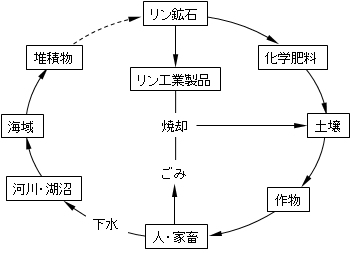
図1 リン鉱石からのリンの循環
Fig.1 Phosphorus circulation from phosphate ore.
2.リンの用途
リン鉱石の用途としては、化学肥料の原料として使われるものが最も多い(約77%)。また、農薬や殺虫剤としての利用も多い。このほか、リンの化合物は研磨剤として歯磨きなどに含まれ、口腔衛生に関係する製品にもリン酸化合物が数多く利用されている。また、コーンフレークや飼料にリン酸化合物が含まれるほか、ハムやチーズにも使用される。燃料の不凍液、繊維製品の難燃加工、製紙工業における消泡剤などに、さまざまな種類のリン酸化合物が利用されている。
なお、日本はリン鉱石を全て海外から輸入している。リンは、この鉱石に加えて、輸入される食料や飼料の成分として国内へ搬入されている。将来、リン鉱石は枯渇する資源である。リンの回収・再利用が望まれる。
2. Uses of phosphorus
Phosphorus ore is most often used as a raw material for chemical fertilizers (about 77%). It is also often used as a pesticide and insecticide. In addition, phosphorus compounds are contained in toothpaste as an abrasive, and many phosphate compounds are used in products related to oral hygiene. In addition, corn flakes and feed contain phosphate compounds, and they are also used in ham and cheese. Various types of phosphoric acid compounds are used for antifreeze of fuels, flame-retardant processing of textiles, defoaming agents in the paper industry, etc.
In addition, Japan imports all phosphate rock from overseas. In addition to this ore, phosphorus is imported into Japan as a component of imported food and feed. Phosphorus ore is a resource that will be depleted in the future. Recovery and reuse of phosphorus is desired.
3.生物学的リン除去
汚水中のリンは、主に有機体リン、ポリリン酸(HO-[PO3H]n-H、オルトリン酸が脱水縮合しした化合物)、オルトリン酸(H3PO4、水素イオンを解離、イオンとして存在)として排出されるが、有機体リン・ポリリン酸は微生物によって分解され、一般的にはオルトリン酸として溶解している。
3. Biological phosphorus removal
Phosphorus in wastewater is mainly discharged as organic phosphorus, polyphosphoric acid (HO-[PO3H]n-H, a compound obtained by dehydration condensation of orthophosphoric acid), orthophosphoric acid (H3PO4, dissociating hydrogen ions and existing as ions). However, organic phosphorus or polyphosphoric acid is decomposed by microorganisms and is generally dissolved as orthophosphoric acid.
(1)リン除去の基本原理
活性汚泥中のポリリン酸蓄積能力もつ細菌の機能を利用して、抜取り汚泥中のリン含有量を高めることで、汚水中のリンを除去する。
ポリリン酸蓄積細菌は、嫌気状態においては、細胞内のポリリン酸を加水分解して得たエネルギー活用して有機物を細胞内へ取り込み、貯蔵物質(例えば、Polyhydroxy alkanoate PHA)へ変換して蓄積を行うとともに、生成したリン酸を細胞外へ放出する。一方で、好気状態においては、嫌気性状態で放出した量よりも多いリン酸を摂取して、ポリリン酸へ変換して細胞内に蓄積する。
このように一旦放出した以上のリンを摂取するので、好気状態においてリン含有量が高まった状態の菌体(汚泥)を取り出すことで、汚水中のリンを除去する。一般的に標準活性汚泥の余剰汚泥には2.3%程度のリンが含まれるが、上記の方法では5~6%まで増加する。
(1) Basic principle of phosphorus removal
Phosphorus in wastewater is removed by increasing the phosphorus content in the extracted sludge by utilizing the function of bacteria having the ability to accumulate polyphosphoric acid in activated sludge.
In an anaerobic state, polyphosphate-accumulating bacteria utilize the energy obtained by hydrolyzing polyphosphoric acid in cells to take organic substances into cells and convert them into storage substances (for example, Polyhydroxy alkanoate PHA) for accumulation. At the same time, the produced phosphoric acid is released outside the cell. On the other hand, in the aerobic state, phosphate is ingested in an amount larger than that released in the anaerobic state, converted into polyphosphate and accumulated in cells.
In this way, since the phosphorus more than once released is ingested, the bacterial cells (sludge) having a high phosphorus content in the aerobic state are taken out to remove the phosphorus in the wastewater. Generally, excess sludge of standard activated sludge contains about 2 to 3% of phosphorus, but the above method increases it to 5 to 6%.
(2)リン除去プロセス
曝気槽の前段に嫌気槽を設置し、汚水を有機物が存在する嫌気状態で1.5~3時間かけて、攪拌して汚泥と接触させ、菌細胞からリンを汚水中へ放出させる。続いて曝気槽で3~5時間かけて好気状態にするとリンが菌細胞内に取り込まれる。汚水中のリン濃度は3~6mg/Lから1mg/L以下にまで低下し、この処理水を放流する。
ここで留意すべき事項として、本プロセスでの嫌気槽とは好気性微生物群集(汚泥)中のポリリン酸蓄積細菌が行う嫌気環境下での挙動を利用することであり、嫌気性微生物群集を利用した嫌気性消化法や高速嫌気性生物法での嫌気槽とは異なることである。さらに、以下に扱う「無酸素」とは、遊離の酸素分子は存在しないが、硝酸や硫酸などの結合性酸素は存在する状態で、「嫌気」は遊離の酸素および結合性酸素のいずれも存在しない状態をいう。
(2) Phosphorus removal process
An anaerobic tank is installed in front of the aeration tank, and sewage is contacted with sludge by stirring for 1.5 to 3 hours in an anaerobic state in which organic substances exist, and phosphorus is released from the bacterial cells into the sewage. Subsequently, phosphorus is taken up into the bacterial cells when it is aerobicized in the aeration tank for 3 to 5 hours. The phosphorus concentration in wastewater drops from 3 to 6 mg/L to 1 mg/L or less, and this treated water is discharged.
It is important to note here that the anaerobic tank in this process is to use the behavior of polyphosphate accumulating bacteria in the aerobic microbial community (sludge) under anaerobic environment. This is different from the anaerobic tank used in the anaerobic digestion method and the fast anaerobic biological method. In addition, the term “anoxic” to be treated below is a state in which free oxygen molecules do not exist but bound oxygen such as nitric acid and sulfuric acid exists, and “anaerobic” refers to a state in which neither free oxygen nor bound oxygen exists.

図2 生物学的リン除去プロセス
Fig.2 Biological phosphorus removal process.
しかし、リンの除去率は、時間や季節によって、pH、温度、負荷および有機物の組成の変化により不安定になることが多い。補完的設備として、凝集沈殿によるリン除去法が併用されている事例が多い。また、リン含有率が高い余剰汚泥の濃縮・貯留中にリンが放出されるので、汚泥処理にも工夫が必要となる。
工場排水では成分と濃度が事例によって大きく異なり、有機物成分・栄養塩・微量元素などを含めた今後の研究が待たれる。
However, the phosphorus removal rate often becomes unstable due to changes in pH, temperature, and the load and composition of organic matter, depending on hour and season. In many cases, the phosphorus removal method by coagulation sedimentation is also used as complementary equipment. Further, since phosphorus is released during the concentration and storage of excess sludge having a high phosphorus content, it is necessary to devise a sludge treatment.
The components and concentrations of factory effluent vary greatly depending on the case, and future research including organic components, nutrient salts, and trace elements is awaited.
(3)窒素・リンの同時除去プロセス
上記のリン除去プロセスの嫌気槽と曝気槽の間に、無酸素槽を導入し、曝気槽からの硝化液を循環させることにより、リン摂取と脱窒の反応を行うことで、リンと窒素の同時除去が可能となる。
(3) Simultaneous removal process of nitrogen and phosphorus
By introducing an anoxic tank between the anaerobic tank and the aeration tank of the above-mentioned phosphorus removal process and circulating the nitrification solution from the aeration tank, the reaction of phosphorus uptake and denitrification is carried out, thereby removing phosphorus and nitrogen, resulting in that the simultaneous removal is possible.
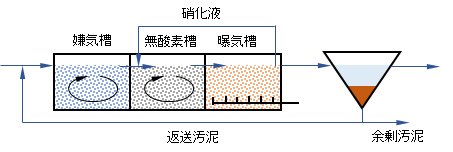
図3 生物学的窒素・リン・同時除去プロセス
Fig.3 Biologically simultaneous removal process of nitrogen and phosphorus.
4.不溶性塩によるリン除去
リン酸イオンは、鉄(Ⅲ)、アルミニウム(Ⅲ)、カルシウム(Ⅱ)、マグネシウム(Ⅱ)などの金属イオンと反応して難溶性塩を形成する。この反応を利用して。汚水中のリンを除去することができる。
4. Phosphorus Removal with Insoluble Salt
Phosphate ions react with metal ions such as iron (Ⅲ), aluminum (Ⅲ), calcium (Ⅱ), and magnesium (Ⅱ) to form sparingly soluble salts. Taking advantage of this reaction, phosphorus in wastewater can be removed.
(1)凝集沈殿法
凝集沈殿剤として、硫酸アルミニウム・ポリ塩化アルミニウムなどのアルミニウム塩または塩化第二鉄や硫酸第二鉄などの鉄塩が広く用いられている。
リンの凝集沈殿に最適なpHは、鉄塩で4~5、アルミニウム塩で6付近である。凝集沈殿法は、微生物フロックの凝集作用もあり生物法と併用され、余剰汚泥とともに系外へ取り出される。
(1) Aggregation and sedimentation method
Aluminum salts such as aluminum sulfate and polyaluminum chloride or iron salts such as ferric chloride and ferric sulfate are widely used as flocculating and precipitating agents.
The optimum pH for aggregation and precipitation of phosphorus is 4 to 5 for iron salts and around 6 for aluminum salts. The coagulation-sedimentation method is used together with the biological method because it also has a flocculating effect on microbial flocs and is taken out of the system together with excess sludge.
(2)晶析法
晶析法とは、一般的には目的結晶を構成する成分を溶解した溶液を加熱または冷却して、過飽和状態にして、結晶を析出・成長させる方法である。汚水中の汚濁物質を結晶(粒子状)化して分離・除去する場合には、一般的に次のようなプロセスから構成される。
晶析槽に汚水を流入し、その物質と結晶を生成する成分(晶析剤)を添加・攪拌し、結晶(粒子状)を析出・成長させ、沈殿槽で結晶を分離して、処理水を放流する。結晶粒子は晶析槽または沈殿槽の底部から抜き出して、晶析槽へ種結晶として返送・循環させる。結晶粒子の一部を定期的・連続的に取り出す。
晶析法では、槽内壁や配管系へ結晶粒子が付着するので、定期的な清掃が必要となる。配管を少なくするため、晶析槽と分離槽を一体化した晶析装置が多用されている。晶析法では、汚水中に懸濁物質が含まれていると、晶析反応の阻害するので、前段で除去しておく。
(2) Crystallization method
The crystallization method is generally a method of heating or cooling a solution in which components constituting a target crystal are dissolved to bring the solution into a supersaturated state and precipitating and growing the crystal. When crystallizing (separating) pollutants in wastewater to separate and remove them, it is generally composed of the following processes.
Sewage flows into the crystallization tank, the substance and a component that produces crystals (crystallizing agent) are added and stirred, and crystals (particulates) grow and precipitate, and the crystals are separated in the precipitation tank, and treated water is released. Crystal particles are extracted from the bottom of the crystallization tank and some particles are returned to the crystallization tank as seed crystals. The crystal grains is taken out periodically and continuously.
In the crystallization method, since crystal particles adhere to the inner wall of the tank and the piping system, regular cleaning is necessary. In order to reduce the number of pipes, a crystallizer that integrates a crystallization tank and a separation tank is often used. In the crystallization method, if suspended solids are contained in the wastewater, the crystallization reaction is hindered, so these are removed in the preceding stage.
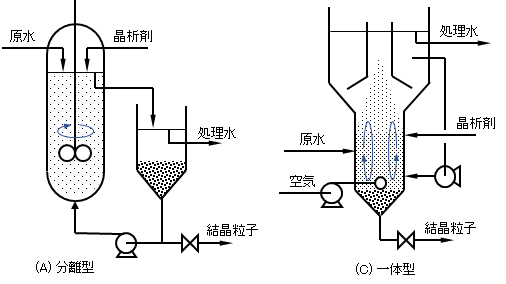
図5 晶析法によるリン除去装置の事例
Fig.5 Example of phosphorus removal device by crystallization method.
The crystallization tank and the separation tank are (A) separate type and (B) integrated type.
1) MAP法は、リンに対して当モル以上のアンモニアが共存する場合に適用されることが多い。
2) HAP法ではカルシウム塩を、MAP法ではマグネシウム塩をそれぞれ添加する。
リン酸イオンとの反応を促進するためアルカリ性(pH 8.5~9)とする。HAP法の留意すべき事項として、リン濃度が低い汚水では種結晶に炭酸カルシウムの被膜が形成し、HAP晶析が阻害されるので、脱炭酸の前処理が必要となることがある。
1) The MAP method is often applied when equimolar or more ammonia coexists with phosphorus.
2) Add calcium salt in HAP method and magnesium salt in MAP method.
It is made alkaline (pH 8.5 to 9.0) to promote the reaction with phosphate ions. It should be noted that the HAP method requires pretreatment for decarboxylation, because calcium carbonate film is formed on the seed crystals in wastewater having a low phosphorus concentration, and HAP crystallization is hindered.
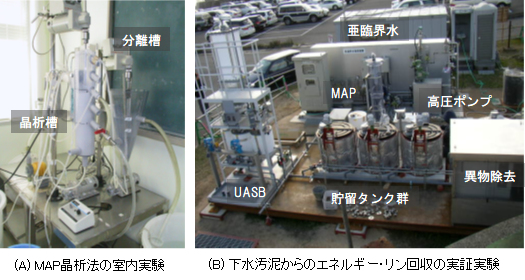
写真 下水および下水汚泥からのMAP法によるリン回収実験の様子
下水処理場の混合汚泥を濃縮・加熱して亜臨界水で加水分解した後、固液分離してMAP法およびUASB法によるリン・エネルギーの回収
Photo Phosphorus recovery experiment using MAP method from sewage and sewage sludge.
After condensing and heating the mixed sludge in the sewage treatment plant and hydrolyzing it in subcritical water, solid-liquid separation is performed to recover phosphorus and energy by the MAP method and the UASB method.
(A) Laboratory experiment of MAP crystallization method. (B) Verification on-site test of energy and phosphorus recovery from sewage sludge.
(3)鉄電解法
鉄塩による凝集沈殿法の一つで、鉄板から電解・溶出した鉄イオンとリン酸イオンを反応させ、生成した難溶解性のリン酸第二鉄(FePO4)として除去する。
直流電源に接続した鉄板を電極(陽極・陰極とも、一定時間間隔で陽極と陰極を切替える)とし、その電解・溶出した鉄(Ⅱ)イオンが、さらに酸素によって酸化された鉄(Ⅲ)イオンとリン酸イオンが反応し難溶性のリン酸第二鉄を生成させて、汚泥とともに分離・除去する。
装置がコンパクトで維持管理が簡便であり、消耗した鉄板電極は定期的に交換する。家庭排水の小型浄化槽に広く適用されている。流入汚水量・リン濃度に合わせて、鉄板面積(枚数を増やしてもよい)および電流量(電源容量)で調整する。
(3) Iron electrolysis method
This is one of the coagulation-sedimentation methods using iron salts, in which iron ions , electrolyzed and eluted from the iron plate, react with phosphate ions to be removed the resulting sparingly soluble ferric phosphate (FePO4).
An iron plate connected to a DC power source is used as an electrode (both anode and cathode switch the anode and cathode at regular time intervals), and the electrolyzed and eluted iron (II) ions are oxidoded to iron (III) ions. Phosphate ions react with the iron(III) to form sparingly soluble ferric phosphate, which is separated and removed together with sludge.
The device is compact and easy to maintain, and the consumed iron plate electrodes are replaced regularly. This is widely applied to small septic tank “Jokaso” in Japan for domestic wastewater. Adjust the iron plate area (the number of sheets may be increased) and the current amount (power supply capacity) according to the inflow sewage amount and phosphorus concentration.
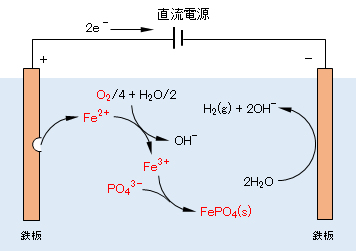
図6 鉄電解法によるリン除去の原理
Fig.6 Principle of phosphorus removal by iron electrolysis。
